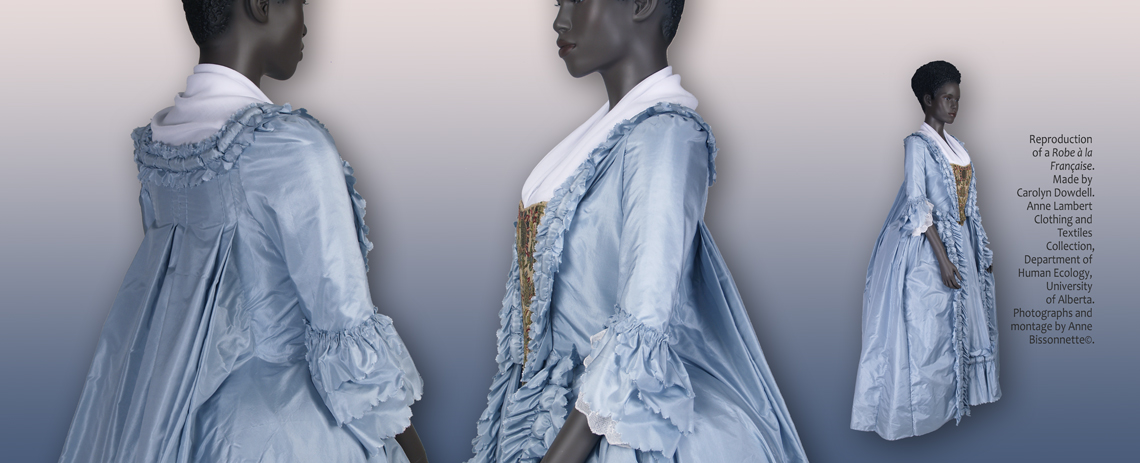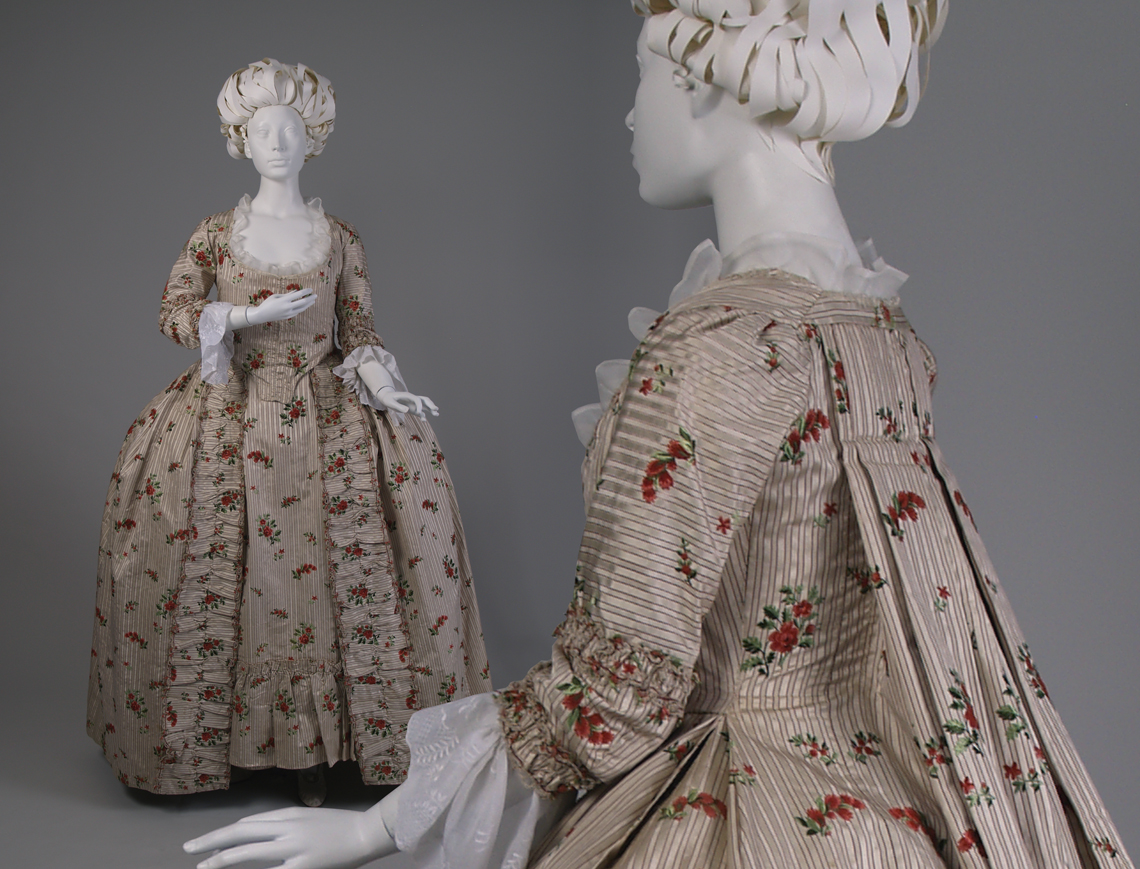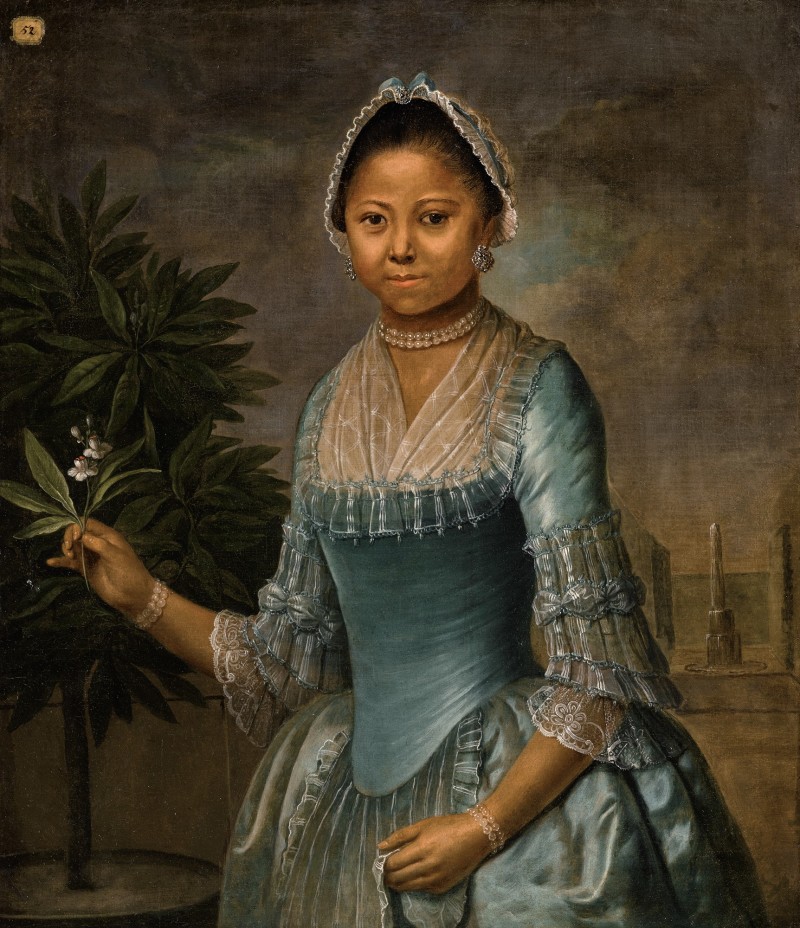
DRESS & ESCAPISM - THE DRESS RESEARCH EXHIBITION SERIES
Part 1 of 3: Dress Artifacts & Curatorial Practices
A Virtual (and Evolving) Exhibition
Anne Bissonnette, Lead Curator
Josée Chartrand and Katelin Karbonik, Contributing Curators
June 30, 2020 – June 30, 2021
Part 1 Home | The Blair Suit Reproduction | The Robe à la Française Reproduction | The Mid-1790s Chintz Gown | The Chemise Dress | The 1796 Reproduction Wedding Gown | The Housemaid's Dress
The robe à la française reproduction
Made by Carolyn Dowdell
Silk, cotton or linen lining
Anne Lambert Clothing and Textiles Collection, Department of Human Ecology, University of Alberta
Mount, photographs, and montage by Anne Bissonnette©
Several graduate students in the Department of Human Ecology have conducted experiential research through the process of making reproduction historical garments. This was the case for the research of MA student Carolyn Dowdell who reproduced a blue silk robe à la française, as well as several other women’s ensembles and underpinnings typical of 1770s high fashion. The pieces were not featured in her 2010 thesis, “The Fruits of Nimble Finger: Garment Construction and the Working Lives of Eighteenth-Century English Needlewomen,” but were nonetheless a building block in her journey.
Like the tailors and mantua-makers at Colonial Williamsburg, Dowdell spent hours sewing by hand in reproduction period clothing using tools and techniques of the period. She also accessed museum artifacts to gain a deeper understanding of labour practices and work conditions in 18th-century England. Her approach to women’s needle skills through observing and reproducing women’s garments was a turning point for her as she learnt to question sources she had previously relied upon:
| “One of the most valuable, fascinating, yet also frustrating consequences of using actual artefacts for the study of dress is how frequently they differ from the paintings and illustrations routinely treated as authoritative representations. At first, being confronted with an artefact that does not conform to any familiar image is unsettling, and the first reaction may be to assume that the artefact is unrepresentative. However, when one moves past the dictates of historical fashion plates and recognizes that the artefact is a survivor of lived history, it becomes the authority and proves the lie of the image.”[1] |
Reproduction gowns can serve scholarly goals and broaden current curatorial practices. Dowdell’s work at the University of Alberta and her 2015 PhD at Queen’s University, “The Multiple Lives of Clothes: Alteration and Reuse of Women’s Eighteenth-Century Apparel in England,” advocates for the close examination of historical clothing to push boundaries of knowledge. The gown she produced presented in this exhibition is also able to fit larger and taller bodies, which enables us to dress it on a contemporary, larger-sized mannequin with African features.
The Anne Lambert Clothing and Textiles Collection has different types of mannequins, some of which are designed to fit historical garments. These mannequins are mostly built with narrow and low, pushed back shoulders, extremely small waists that are able to be raised or lowered from the lower body, removable legs, and small feet. Many of these body doubles have been developed through the years by specialized manufacturers to support the posture and features of different historical silhouettes. The market for such mannequins is very small and decreasing steadily. As a result, choices in mannequins are few. Curators select surrogate bodies that can fit as many historical garments as possible and these bodies inevitably come with Caucasian features and slim silhouettes. These are typically offered and presented on exhibition in white.[2]
No mannequin is neutral: the colour, material, features, size, and composition of a mannequin all impact the manner in which an audience perceives its race, age, gender, ability, and size. The world is diverse, and museums must seek to represent diversity in exhibition as a standard in a world where manufacturers of mannequins for historical garments do not offer choices in this domain. As a result, the narrow aesthetic boundaries for the exhibition of clothing continue to be the norm in the display of fashion, both past and present. Increasingly, mounts have no visible heads of limbs. Is this the new neutral? How can curators factor in hairstyles that constitute an important facet of dress behaviours? One may wonder if the resistance to evolve is only rooted in supply and costs or if there is a comfort in simply maintaining the status quo. Whichever way, this needs to change and the key may already exist in 3D-printing: this medium has the ability to print scans of different facial types in a variety of colours.
While rigorous in nature, museum exhibitions are, like stage and film, impacted by current fashion and aesthetics which are dominated by a multitude of stereotypes. From the subject-matter and artifacts selected to the ways objects are mounted and staged, a curator is an individual “of the world and in the word, but also [one who] shapes the world.”[3] The curator’s eye is influenced by contemporary fashion and spectacles, but they also hold the power to influence others through their work. The on-going tendency of curators to select and present relatively small-sized garments on white mannequins they see as neutral can, for instance, affect individuals of different sizes and races who may not see themselves in the story presented. This greatly impacts efforts to represent diversity and to de-colonize popular conceptions of history. Clothing, more than any other type of artifacts, can help change people’s ability to relate to history as visitors often love to imagine themselves wearing a garment on display.
This exhibition is only a start. Severely impacted by the onset of Covid-19, the selected artifacts were not all exhibited as planned. The intention was to mount all reproduction artifacts (typically large in size) on newly purchased grey linen dress forms with grey linen heads and arms made to look like dark wood. An added fabric cover of the same dark-coloured wood over the head or a 3D-printed head scan was part of our initial plan. The women’s dress forms arrived and were too broad at the shoulders and their breasts were too generous, as is the case for contemporary mannequins available for purchase. The arms were also sent in the wrong lighter colour. Even with the endeavour to order non-white mannequins, this exhibition’s efforts to achieve broader representation were thwarted by the supply chain.
Modifications of fiberglass mannequins is possible by skilled individuals. This types of “doctoring” of existing mannequins and dress forms is often done to display clothing artifacts and must be conducted to correctly present certain bodies including transgender dress. In 2018, Iowa State University removed the bust from a female mannequin to exhibit a body that had undergone top surgery thus demonstrating how mannequin modifications can achieve more inclusive representation in fashion exhibition.[4] Having access to more representative materials and being willing to modify them to suit the needs of diversity and equal representation must become part of curatorial practices.

Figure 1
Off white striped floral robe à la française and matching petticoat
Unknown creator, France, 1775-mid 1780s
Silk brocaded exterior, bodice lined in linen
Anne Lambert Clothing and Textiles Collection, Department of Human Ecology, University of Alberta
Purchase (2014.1.1ab)
Worn with:
Whitework engageantes
Unknown creator, England, 18th century
Cotton Mull plain weave with whitework embroidery
Anne Lambert Clothing and Textiles Collection, Department of Human Ecology, University of Alberta
Purchase (2014.1.8)
Ivory shoes
Unknown creator, Europe, ca. 1785
Silk satin, cotton or linen lining
Anne Lambert Clothing and Textiles Collection, Department of Human Ecology, University of Alberta
Purchase (2017.7.1)
Paste buckles
Unknown creator, England, 18th century
Metal and rhinestones
Anne Lambert Clothing and Textiles Collection, Department of Human Ecology, University of Alberta
Purchase (2017.7.2)
Mount, paper hair, photographs, and montage by Anne Bissonnette©

Figure 2
Hand-colored engraving on laid paper from Gallerie des Modes et Costumes Français, 41e Cahier (bis) des Costumes Français, 36e suites d'Habillemens à la mode en 1784. Pour servir de supplément au 6e Cahier des Coeffures.
Plate xx 263, "Grande Robe Françoise qui étoit celle d’étiquette au voyage de Fontainebleau 1783."
Designed by: Pierre-Thomas LeClerc (French, about 1740–after 1799)
Engraved by: Pierre-Charles Baquoy (1759–1829)
Publisher: Esnauts et Rapilly (French, 18th century)
Paris, France, 1784
38.1 x 24.1 cm
Museum of Fine Arts, Boston
The Elizabeth Day McCormick Collection (44.1577)
www.mfa.org
Link to museum artifact

Figure 3
Portrait of a Lady Holding an Orange Blossom
mid-18th century
oil on canvas (80 × 56.2 cm)
Art Gallery of Ontario
Purchase, with funds from the European Curatorial Committee, 2020 (2019/2437)
Link to museum artifact
Do you know of other interesting strategies to address racial stereotypes in museum exhibitions?
Share your thoughts by e-mailing anne.bissonnette@ualberta.ca and join the conversation about diversity in exhibition design!
|
On September 16, 2020, we had a response not to the question asked but regarding how, as researchers, our perspectives change over time: "[A] response to my quote for you to add/post: “One of the most valuable, fascinating, yet also frustrating consequences of using actual artefacts for the study of dress is how frequently they differ from the paintings and illustrations routinely treated as authoritative representations. At first, being confronted with an artefact that does not conform to any familiar image is unsettling, and the first reaction may be to assume that the artefact is unrepresentative. However, when one moves past the dictates of historical fashion plates and recognizes that the artefact is a survivor of lived history, it becomes the authority and proves the lie of the image.”[1] Since I wrote this statement (over ten years ago) I have become much more aware of the impact of alterations on historical garments. Nearly all surviving eighteenth-century garments are altered in some way, with those performed in the nineteenth century being the single most common type. This can significantly distort the perception of eighteenth-century dressmaking and sartorial conventions if you aren't already familiar with dressmaking from this period and the prevalence of alterations. So, while my statement wasn't entirely wrong it was certainly not entirely correct, either. Depending on the context, the object may be a more reliable authority than visual representations but this is not always the case. Yes, it is a physical survivor from the period in which it was made but has not remained untouched through the intervening years, decades, centuries. Surviving garments are an indispensable resource for the study of Dress History but are most useful when contextualized with other visual and written sources." Carolyn Dowdell
|
[1] Carlyn Dowdell, “The Fruits of Nimble Finger: Garment Construction and the Working Lives of Eighteenth-Century English Needlewomen” (master’s thesis, University of Alberta, 2010), 118, https://era.library.ualberta.ca/items/92d65301-774c-4472-90e0-3a93f409352a.
[2] Julia Petrov points out that Benjamin Moore even has an off-white tint named “Mannequin Cream.” See Julia Petrov, Fashion, History, Museums: Inventing the Display of Dress (London: Bloomsbury Visual Arts, 2019), 165.
[3] A quote used by Karl Aspelund to contextualize fashion designers. See Karl Aspelund, Fashioning Society: A Hundred Years of Haute Couture by Six Designers (New York, NY: Fairchild Books: 2009), xv.
[4] Chloe Chapin, Denise Nicole Green, and Samual Neuberg, “Exhibiting Gender: Exploring the Dynamic Relationships between Fashion, Gender, and Mannequins in Museum Display,” Dress 45, no. 1 (2019): 75-88.
Support for the exhibition was provided by a KIAS Dialogue Grant from the Kule Institute for Advanced Study and a CIP Artist Project Grant by the Edmonton Arts Council and the City of Edmonton.



This exhibition also draws on research supported by the Social Sciences and Humanities Research Council. The following individuals have contributed to Dr. Bissonnette’s research thus far: Josée Chartrand, Meg Furler, Peggy Isley, Katelin Karbonik, Patricia Siferd, and Sarah Woodyard.

